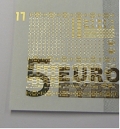We all know how currency printers, security device suppliers and counterfeiters are constantly trying to outsmart each other. A recent paper published in the periodical Advanced Materials. It seems that science has advanced to the extent that it is now possible to print a transistor circuit onto paper using organic compounds. The science of this is far beyond my comprehension, but I do understand the basic principle.
A printed circuit can be “read” using micro voltage electronics making it possible to design detectors for every-day application that would ensure the authenticity of every note bearing a TFT (thin film transistor). The TFT can be buried in the design of the note and would therefore be invisible to the naked eye. The “signature” of the TFT could also be encrypted thereby making it virtually impossible for the modern counterfeiter to hack. Could this be the saviour of printed money? Perhaps, since one of the principle societal costs of physical currency is the cost of counterfeiting.
Lisa Wylie is a contributing writer to materialsviews.com and she had this summary of the technology and its potential impact:
Circuits Circumvent Counterfeit Currency
Banks and mints use a wide variety of methods to foil (as it were) attempts to print one’s own money. Up to now, those methods have been essentially passive – fluorescent inks, foil strips, holograms and watermarks, to name but a few. Imagine how much more effective a deterrent to theft and counterfeiting a more active form of security would be. If banknotes could incorporate a transponder circuit, or a unique RFID tag, they could be tracked and identified wherever they went, and building a circuit into something as delicate as a banknote is far more difficult than setting up printing plates in your garage.
But just how do you add circuitry to a banknote? Conventional electronics processing is too destructive, and conventional circuitry, even miniaturized as far as possible, is still far too large to be effectively useful. Enter the work of Ute Zschieschang and an international team from Germany and Japan. Using dry processing conditions (vacuum deposition) the team were able to pattern arrays of thin film transistors onto the surface of a 5-Euro note, and even build circuits using the transistors. Out of every 100 transistors deposited, 92 were operational, a more than good enough yield for the circuits to work reliably. Looks like your money is set to become a little bit safer.
Let’s hope so! For those of you interested enough to read the complete paper, you can access it here.










